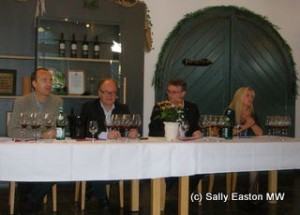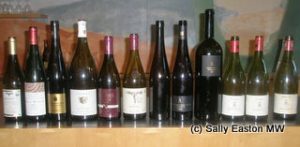German pinot noir, emerging excellence

L-R: Greiner, Fürst, Rebholz, Maurer
The recent emergence of German pinot noir (spätburgunder) on the world stage was revisited with this tasting seminar, held at Staatsdomäne Assmansshausen in Rüdesheim, Germany, in late September 2009, as part of a Master of Wine visit to the region.
Panellists for the seminar were Dieter Greiner of Kloster Eberbach-Domäne Assmannshausen, Paul Fürst of Weingut Rudolf Fürst, and Hansjörg Rebholz of Rebholz estate. It was moderated by Caro Maurer, a journalist in Germany and Master of Wine student.
One might be forgiven for imagining Germany and riesling in the same breath, but a third of the German vineyard is planted to red grape varieties, with pinot noir accounting for a grand 12% of the total, a figure that’s tripled in the past 30 years, and which, if plantings for Champagne are excluded, is about the same as for France.
And it’s the past 30 years that has witnessed a revolution in red-winemaking in Germany. It coincided with a change of generation, including Rebholz and Fürst, who took over the family estate and went travelling, especially to Burgundy. Prior to this red wine making was generally, though not always, as for white wine, so a short fermentation, no time on the skins, no malolactic fermentation, resulting in high acid wines that were sweetened to balance them.
These leading lights of the new generation started making their red wines as red wines. And the usual gamut of experimentation followed: pre-fermentation cold maceration, extended time on skins, the introduction of oak etc. Then moved into the vineyard with lower yield management: harder winter prunings, green harvest during the growing season, foliage management as well as the search for higher quality clones, such as Burgundy clones 113, 114, 115, 667 and 777, plus new ones from Geisenheim Research Centre, the type 20 clones, which give lower yields and smaller berries with more concentrated fruit. Even as the pinot noir vines age, new dimensions are developing in spätburgunder.
And as with such a ‘young’, experimenting industry, Maurer said: “There is no ‘German pinot noir’ [style]. We have so many different climates and soils, from slate to coloured sandstone. We have the most vivid acid, generally showing more fruit than other pinot noir producing areas, keeping the balance between fruit and acidity.”
She added: “For us, pinot noir is prestigious. Like riesling, it shows its climate and its soil: pinot noir is as the red riesling. It’s our terroir variety.”
Given pinot noir’s propensity to reflect its local site, there is a reversion to vineyard site, which is how the German vineyards used to be organised hundreds of years ago. Maurer said: “we’re not using pradikats, such as spätlese or auslese, for pinot noir so much, we’re more concentrating on the [vineyard] sites, such at Centgrafenberg.”

The wines
As part of this experimentation, a modernist approach was also discussed. Fürst said: “I find some important things with these wines. Slate soils are very different from the others. Then, Huber and Becker represent the modern German interpretation of spätburgunder, which is what we all want to do now. In winemaking it is very important to go to lower extraction, use gentle work with the grapes, to get more silkiness and more freshness.”
Tasting notes, September 2009.
The main regions for pinot noir are Ahr, Württemberg, Baden, Franken and the Pfalz.
The tasting seminar was orientated around terroir: slate soils, volcanic soils, limestone, and sandstone soils.
The tasting comprised wines retailing between €30 and €100.
Wines 1 to 3 come from slate soils, which is said to give lower tannins, softer fruit, more red berries and redcurrant, less cherry fruit.
Wine 4 comes from volcanic soils, which is said to give richer, fuller bodied wines, with spices, more opulent.
Wine 5, plus 7 to 9 are from limestone soils.
Wines 10 to 12 are from variegated sandstones.
Wine 1. Kloster Eberbach, Domäne Assmannshausen, Hollenberg Spätburgunder spatlese trocken 2004, Assmanshausen, Rheingau
Greiner “a classic late ripening vintage with good acidity, picked at the end of October. Cold winds at night keep the acidity level.”
Spicy, hint rumtopf on the nose, black berry, uplifting volatile acidity and slight green notes at back of nose; medium length.
Wine 2. Weingut August Kesseler, Berg Schlossberg Spätburgunder 2007, Assmanshausen, Rheingau
The top wine from the winery. Greiner: “dense planted vineyards, 25-year-old vines. He’s using new Geisenheim clones with tiny berries. Barrique for 18 months, 50% new.”
Medium cherry colour, fresh and linear profile with very smooth texture, rich berry fruits of the forest. Elegant, young, and lightly chewy tannins, with youthful intensity, concentration and balance. Very long finish. Excellent.
Wine 3. J.J. Adeneuer, Garkammer Spätburgunder Grosses Gewächs 2007, Ahrweiler, Ahr
Smoky, hint of lifting volatile acidity; medium weight. Red berry and cranberry background on the palate. Smooth light tannins, long palate and finish. Freshness throughout the palate. Good length.
Wine 4. Weingut Salwey, Kirchberg Spätburgunder Grosses Gewächs 2003, Oberrottweil, Baden
Hint tarry, warm, ‘sweet’ fruit, higher glycerol. Not so much length, acid balance quite broad in comparison with further north. Full-fat, sweet, very ripe fruit.
Wine 5. Bernhard Huber, Wildenstein Spätburgunder R, 2007, Malterdingen, Baden
Maurer: “He cuts the shoulders of the bunches and tips to have round bunches. One week cold maceration; pigeage in wooden fermenters. On skins for 21 days in total.”
Crunchy red cherry fruit, perky, fresh, focused. Smooth texture, but more tannin, felt on mid palate. Youthful, ripe, grainy tannins at core for framework. Uplifting palate with freshening acidity. Great acid/fruit rapier edge, warm tannins add framework. Very good. Plenty of all the right things to age this one. Long finish.
Wine 6. Friedrich Becker, Pinot Noir Schweigen, Pfalz 2007, Tafelwein trocken
This one has to be called a tafelwein, because the fruit is from France, along the Alsace/Pfalz border. The vines are considered German, though. Long, geopolitical history in this part of the world.
Maurer: “Fourteen day fermentation in wooden fermenters. No extended time on skins; 100% new barriques.”
Closed nose, warm spicy open knit fruit. Less focused than previous wine. This would have to be good value, but even €30 wouldn’t be. Hint hot on the finish.
Mini vertical of Rebholz estate
Rebholz: “We are in the southern part of Pfalz, 1 km from the Becker estate. There is a group of five estates of the southern Pfalz, we travel to foreign wine regions. One of our goals is to find the perfect quality of pinot noir. There is a long tradition of pinot noir in our region, with a French introduction in the Middle Ages. We have perfect soil with limestone, like in Burgundy, and similar weather conditions to Burgundy.“
Wine 7. Rebholz Estate, Im Sonnenschein Spätburgunder Grosses Gewächs 2007, Sibeldingen, Pfalz
A sample, ready for bottling. Spicy new oak, still overt, with plenty of fresh red berry fruit alongside; very young, balanced. Oak will integrate. Fruit is lovely and fresh, slightly masked currently by the oak.
Wine 8. Rebholz Estate, Im Sonnenschein Spätburgunder Grosses Gewächs, 2004
Creamy texture, hint of lifting volatile acidity with smooth texture, some savoury development, and with soft red berry fruit. Long finish. Going to a savoury, puréed fruit cake note.
Wine 9. Rebholz Estate, Spätburgunder gold 1997
Smoke and aromatic tar, developing softly and roundly, tannins softening but still have some grip, a bit more than pinot noir this old might normally have. Mellow for sure, warming finish.
Mini vertical of Weingut Rudolf Fürst
Wine 10. Rudolf Fürst, Centgrafenberg Spätburgunder R, 2006 Burgstadt, Franken
Fürst: “We harvested before the rain around Oct 3. With warm nights, it was a medium year, but interesting for spätburgunder. This is what we want to produce in future, better and better wines. We don’t have many old vineyards with good genetics; we planted vineyards with good genetics in last 15 to 20 years. We have to wait for these to grow up. The style and minerality of this wine are typical, a dancing on the tongue and in the mouth, with power.”
Aromatic strawberry nose, elegant and fruit-focused. Crunchy red cherry attack. Oak tannins in supportive background, fruit/acid balance to the fore. Long palate and long finish. Some attractive purity of fruit definition, lightness, a moment of ethereality.
Wine 11. Rudolf Fürst, Centgrafenberg Spätburgunder R, 2003 Burgstadt, Franken
Warmest year, harvested three weeks earlier than normal.
Aromatic spicy strawberry fruit, medium weight, red cherry. Some dry notes at back palate from heat of vintage. Red fruit still fighting forth.
Wine 12. Rudolf Fürst, Centgrafenberg Spätburgunder R, 1997 Burgstadt, Franken
Fürst: “one of my best years with my grapes. It was a late harvest, Oct 20th, but we were not so good at winemaking at this time: more extraction, dark colour, strong tannins. At the time people liked this style. Now my winemaking is gentler, with more silkiness.”
Smoky nose, most deeply coloured. Savoury development, even a hint of dried meat, smooth texture and framework are in place, weight and roundness exaggerated from more modern style now made by Fürst.
Comments
One Response to “German pinot noir, emerging excellence”




March 15, 2010 at 3:46 pm
Excellent article. Yes, German Pinot Noirs are entering the world stage, but slowly.
http://www.schiller-wine.blogspot.com/2010/01/german-pinot-noirs-are-increasingly.html